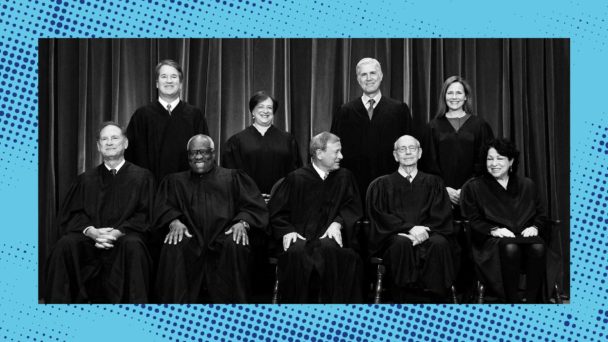Much of the debate around Supreme Court expansion consists of handwringing speculation about the theoretical chain of events that might unfold if Congress were to add seats to the bench. Critics often contend that expanding the Court would kick off an era of never-ending growth; every time power changes hands in Washington, the argument goes, a new retaliatory expansion bill would pass, and the sheer number of justices would quickly render the Court unwieldy and useless.
Now, thanks to professors Adam Chilton, Dan Epps, Kyle Rozema, and Maya Sen, we have some data-driven predictions about the practical effects of Court expansion. In a new study, they use simulations to model how tit-for-tat Court-packing might affect control of the Court over the next 100 years. Under the status quo, the authors estimate that the Court won’t have a majority of Democratic appointees again until 2065. For context, we are closer in time right now to the release of Michael Jackson’s Thriller.
(The study is also a story of missed opportunities: The authors estimate that if Justice Ruth Bader Ginsburg had retired before 2015, or if Senate Republicans hadn’t blocked Merrick Garland’s confirmation in 2016, the Democratic-leaning justices would have regained control of the Court in 2029 and gone on to control it for about half of the next century.)
Our findings have a lot of relevance for policymakers interested in Court expansion. But one particularly salient one: without Court expansion, Democrats are unlikely to retain control of the Court until…2065. pic.twitter.com/W6p5ELkgu0
— Dan Epps (@danepps) May 8, 2023
On the other hand, were the Democrats to fire off the first Court-packing volley, the authors estimate that the Court’s size would balloon to 37 justices after 100 years—and that Democrats, by moving first, would control the Court for 55 of them. The findings, they conclude, “suggest that a party with a minority of justices on the Court may potentially enjoy large benefits due to increased control of the Court if it initiates a cycle of Court-packing.”
The Supreme Court’s most recent term, during which the justices eviscerated the right to abortion care, greenlit four executions in a single week, and dramatically expanded gun ownership rights, is only a preview of what’s to come if Democrats do not act. Already, this conservative supermajority is preparing to end affirmative action in higher education; next term, it might give reactionary judges veto power over any executive agency action they don’t agree with. They are targeting any and every progressive legal win over the past century, and are showing no signs of slowing down anytime soon.
Failing to expand the Court would be a political failure for the Democratic Party. But more importantly, it would be an existential crisis for the millions of women, poor people, people of color, LGBTQ people, and members of other marginalized communities whose rights are disappearing on this Court’s watch. The question that remains is whether Democratic elected officials are listening to warnings like the conclusions of this study, or are content to keep looking the other way.




